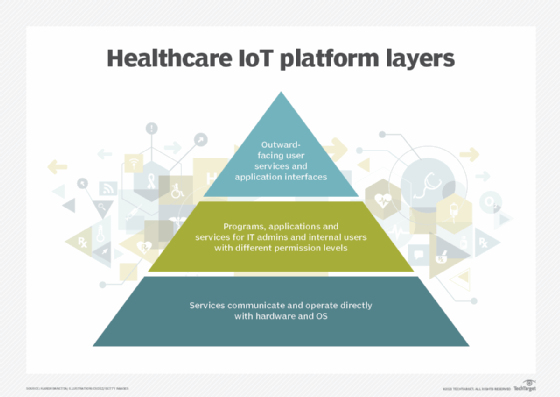
everythingpossible - Fotolia
Interoperability, AI comprise healthcare IoT platform essentials
Healthcare organizations can save providers' time with IoT platforms that combine data types for easy use and derive greater insights through patient health monitoring.
Healthcare technology relies on constant management of many disparate data types and services to give the best possible patient care, which makes a healthcare IoT platform essential to effective treatment. These IoT platforms can simplify data processes to help healthcare teams focus on what they do best, without having to master every service in the hospital.
Digital healthcare data comes from multiple sources such as audio files, transcriptions, test results, wearable device data, confidential patient health history files, appointment schedules and insurance billing systems.
The IoT platform unifies computing elements to overcome the challenge of managing different data types and constantly monitors and updates security protocols throughout the IT system.
What does a healthcare IoT platform do?
Data transmission, storage and processing across health services complicates unified system creation and requires financial or internal staffing commitments that many organizations are not equipped to handle. Healthcare IoT platforms can handle many common functions that support underlying healthcare IoT computing infrastructure, including security, storage, system maintenance and monitoring, as well as power consumption for computing loads.
Healthcare IoT platforms can be thought of as a service layer pyramid. The lowest layer communicates and operates directly with the hardware and OS.
Higher in the pyramid, layers include programs, applications and services that serve different levels of authorized users with greater permissions. For example, in applications, IT admins use tool suites to develop new programs and UIs that provide secure and limited access to IoT device data and interface subsets.
The platform's highest layer represents the outward-facing user services and application interfaces.

Healthcare providers can use such platforms to collect data for health monitoring in facilities or at home, such as heart monitors that periodically record stats from a patient's pacemaker and transmit them to a doctor's office. Providers can also use platforms with patient glucose monitors. Such wearable sensor devices make continuous monitoring possible, and platforms can generate alerts in real time to ensure patients receive prompt treatment.
Healthcare IoT platforms can also connect to ingestible sensors used in tests to investigate a person's digestive tract or to smart bandages and stitches that gather information on a patient's healing progress.
Choose a healthcare IoT platform in 4 steps
Organizations have many aspects to consider when they select an IoT platform that works best with any current technology.
- An organization must identify what its goals are and what value the healthcare IoT platform adds to achieve those goals.
- IT admins must understand the organization's data, security and privacy needs to ensure protected access to authorized users across different layers of the platform.
- IT admins must ensure the platform, IT systems, IoT products and service interfaces are interoperable. This includes understanding the latency and response time for specific services, especially if the platform is expected to scale with new products and services. Failure to check compatibility beforehand could necessitate a complete rebuild from the ground up or expensive transfers of existing data and services.
- The platform's application development should help developers create applications with UIs made for ease of use that adhere to standards for populations with different abilities, such as clients with hearing or vision impairments.
How AI influences healthcare platform decisions
Machine learning propels healthcare organizations to provide better security and a deeper understanding of the relationships and trends in patient data. In a 2020 IEEE survey of CIOs and CTOs in the U.S., the U.K., China, India and Brazil, 32% agreed that AI emerged as one of the most critical game-changing technologies. Healthcare organizations are at the helm of machine learning and must use AI to remain competitive and secure in the IoT healthcare platforms.
When selecting a healthcare IoT platform, organizations must understand which platform functions use AI and IoT data, the testing and validation protocols for AI, and how the AI updates.
If a healthcare organization uses AI for security, the organization must confirm if the patient data is used to retrain and update the AI's knowledge base to best reflect and improve the AI's trustworthiness.








